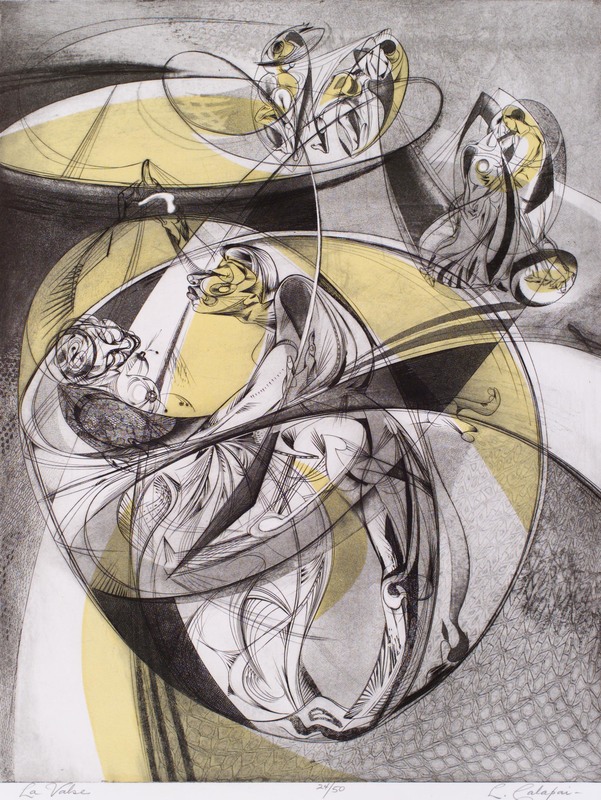La Valse
Item
Title
La Valse
Creator
Letterio Calapai
American, 1902–1993
American, 1902–1993
Date
1951
Materials
Engraving, soft-ground etching, aquatint, and gauffrage with stencil
Measurements
Plate: 22-5/8 x 17-9/16 in. (57.6 x 44.6 cm), sheet: 27-3/16 x 21-7/8 in. (69.1 x 55.5 cm)
Description
Letterio Calapai was born and raised in Boston, Massachusetts. Although his family was not wealthy in the usual sense, it was, as the artist would later recount, “rich in the pleasures of music, poetry, and art.” His father loved poetry and his mother was a pianist. Although provided violin lessons from an early age, Calapai inclined more so toward the visual arts. He attended the Massachusetts College of Art, graduating in 1925, and then spent two years at the School of Fine Arts and Crafts in Boston. In 1928, he moved to New York, where, after furthering his studies at the Art Students League and the American Artists School, he launched his career as an artist, garnering his first solo exhibition in 1933.
As a printmaker, Calapai initially preferred wood engraving, and, at least through the mid-1940s, his subject matter adhered for the most part to a reasonably faithful rendition of the objective world. In 1946, ostensibly to familiarize himself more intimately with the intaglio processes, Calapai joined Atelier 17 and subsequently began to explore the abstract realm of printmaking. At first glance, La Valse, replete with workshop innovations such as white reliefs and textile-textured soft grounds, appears as though it might belong to the more fully nonrepresentational images he produced during this period. A closer look, however, discerns several embracing couples enveloped within individual pockets of gracefully flowing lines. Considering its title and date, one wonders if the work was intended to reference the 1951 debut at the New York City Ballet of Maurice Ravel’s La Valse (initially completed in 1920 but combined by Balanchine with the composer’s earlier Valses nobles et sentimentales for the New York program), of which, considering his musical heritage, Calapai may very well have been aware. In the original score, Ravel offered a program note that seems equally appropriate as a description of the print on view:
Through whirling clouds, waltzing couples may be faintly distinguished. The clouds gradually scatter: one sees an immense hall filled with a swirling throng. The stage is gradually illuminated. The light of the chandeliers reaches its peak at the fortissimo. An imperial court, about 1855.
The text for this label, in particular the linking of Calapai’s imagery to Ravel’s La Valse, has been adapted in part from an unpublished essay by former Penn State art history graduate student Barbara Kutis (MA 2007).
As a printmaker, Calapai initially preferred wood engraving, and, at least through the mid-1940s, his subject matter adhered for the most part to a reasonably faithful rendition of the objective world. In 1946, ostensibly to familiarize himself more intimately with the intaglio processes, Calapai joined Atelier 17 and subsequently began to explore the abstract realm of printmaking. At first glance, La Valse, replete with workshop innovations such as white reliefs and textile-textured soft grounds, appears as though it might belong to the more fully nonrepresentational images he produced during this period. A closer look, however, discerns several embracing couples enveloped within individual pockets of gracefully flowing lines. Considering its title and date, one wonders if the work was intended to reference the 1951 debut at the New York City Ballet of Maurice Ravel’s La Valse (initially completed in 1920 but combined by Balanchine with the composer’s earlier Valses nobles et sentimentales for the New York program), of which, considering his musical heritage, Calapai may very well have been aware. In the original score, Ravel offered a program note that seems equally appropriate as a description of the print on view:
Through whirling clouds, waltzing couples may be faintly distinguished. The clouds gradually scatter: one sees an immense hall filled with a swirling throng. The stage is gradually illuminated. The light of the chandeliers reaches its peak at the fortissimo. An imperial court, about 1855.
The text for this label, in particular the linking of Calapai’s imagery to Ravel’s La Valse, has been adapted in part from an unpublished essay by former Penn State art history graduate student Barbara Kutis (MA 2007).
Source
Palmer Museum of Art, The Pennsylvania State University
Identifier
2005.7
Rights
This image is posted publicly for non-profit educational uses, excluding printed publication. Other uses are not permitted.

